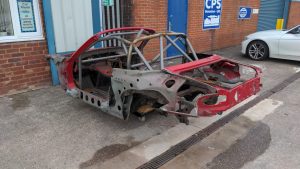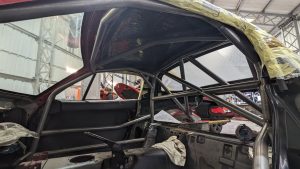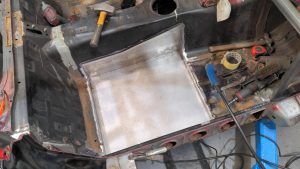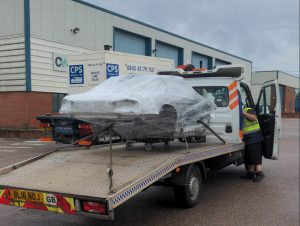Mazda MX5 Build Phase 1

It has to be 10 years now since we converted two of the five original “Shimmy Racing” Mazda MX5 race cars that we campaigned in the Ma5da championship to run slightly higher power than the allowed 135.
Originally a fairly stock 1.6 Mk1 MX5, as per series regs, two of the driver-owners decided they wanted to race elsewhere, but a performance upgrade was required.
It was a fairly obvious upgrade path, we added performance cams, throttle bodies, a standalone ECU, and ditched some more weight.
We raced in the appropriate class with the CSCC for a few years at around 170bhp, then one of the owners sold to another customer of ours, and the other opted to go for more power and fight it out with the bigger boys – there was only one route to go from here – turbocharged.
And so, #111 got upgraded again – better braking, improved handling and running a safe amount of power just north of 300bhp.
It held its own very, very well, running in the same class as Porsche Boxsters and E36 / E46 M3’s, often emerging victorious.
I do remember watching back some footage from a race at Silverstone, not only did we have a storming start off the line, but the driver very skilfully negotiated his way around quite a serious four car pileup, his ninja like reflexes coming into play – and to top it off, on the back straight, despite our roofless aero disadvantage managed to out-sprint an E46 M3!
However, being built as a car for a series, then upgraded, then upgraded again, it was left wanting in a few key areas. Because it was an already built car that was added to, major changes were not really possible. We still had a cage that didn’t allow for fitment of a hardtop (which leaves you not only getting wet, but with a massive aero disadvantage) and also didn’t truly collect the chassis pick up points as we’d have liked. The shell was also carrying a lot of excess weight that is impossible to remove unless a full rebuild is undertaken, and as you can imagine carried a lot of battle damage and the inevitable sill rot, that although was considered acceptable 10 years ago for a race car, doesn’t really fit the bill anymore as time had further taken its toll.
The wiring had been trimmed back for the original race series, then the engine loom replaced when converted to standalone, but the turbo conversion had meant a few additions had been made to this new loom, and the car still ran all of its original antiquated control gear, original Mazda wiring, relays and fuse boxes. It was certainly a car that had indeed been used, and it was getting very, very tired.
Until now…
It is time to start over.
A relatively rot free shell was procured, and we set to work. The aim was to rid it of as much weighty steel as possible, strip it back to its bare skeleton, and start with a clean slate.
We hadn’t fully decided the specification at this point, we knew it would be a rebuilt version of the previous turbo engine with an emphasis on reliability over outright power, we wanted as light as possible, we wanted an endurance configuration, a roof would be ideal, modern electronics along with traction control as getting the power down in the cars previous iteration was far from ideal at times. A lot of this could be decided further down the line.
Work began on preparing the shell, the first job was to strip back to the absolute bare minimum. Once we had just a metal shell sat in the workshop we started to remove panels that were to be replaced – some of these are easy, doors, boot, bonnet and front wings. Some are more difficult – rear quarter panels, full sills, front torque panels – it was at this point we could assess the rust damage and plan a repair.
It was decided to acid dip the shell not only to remove all of the excess seam sealer and underseal to save weight, but also to make repair work easier as we would have clean steel to work on.
Due to a miscommunication with the company contracted to undertake this work, we were put somewhat behind schedule. This meant slower progress than planned due to the fact that we would be a few months behind, and as we had other race work booked in we couldn’t carry on with the build at full speed.
We did however manage to get some work underway in between other jobs. The basics of the roll cage were installed, leaving a few sections that would either be in our way, or that we hadn’t yet made. We also managed to fabricate the section of inner sill that needed to be replaced the length of the driver side.

The other major job we managed to undertake was the lowering of the floor. It’s a tall order to fit a 6ft driver into an MX5 at the best of times, but couple that with a roll cage that allows the fitment of a hardtop, you are decreasing what little space we had to fit a driver in. We couldn’t go up, so the only option was to go down. The floor pan on both sides under where the seats would mount was removed and new floor fabricated 40mm lower than the original to give us the space that we needed.

A lot of weight reduction was completed by removing steel that we knew we would not be needing. All of the metal that we removed, that we knew would not be replaced was weighed, and it puts this build like for like at around 50kg lighter than the original. We also took the opportunity to rework the inner rear arches as we had the rear quarters removed. A common issue among lowered MX5’s is the interference between the tyre and the inner arch behind the quarter. We now have an extra 55mm ride height reduction if we needed it.
Some further rough cuts were made where we knew we would be removing existing body to allow the fitment of a 100 litre fuel tank, knowing that we can tidy this up once the shell was back from dipping. The last job we managed to squeeze in prior to our dipping date was to modify the front bulkhead to allow the fitment of a race pedal box assembly.
The day arrives for transportation to the acid dippers and our last job was to weigh the shell, just so we could see how much weight was lost removing paint, seam sealer and underseal from the shell.
Then we waved goodbye – and had three weeks patiently waiting for its return while we planned to next few steps of the process – planning the final specification of the build and preparing the panels for reassembly – and one exciting word was being floated around…. “airjacks” ….
Exciting times ahead!

© TrackToys Racing - 2024







